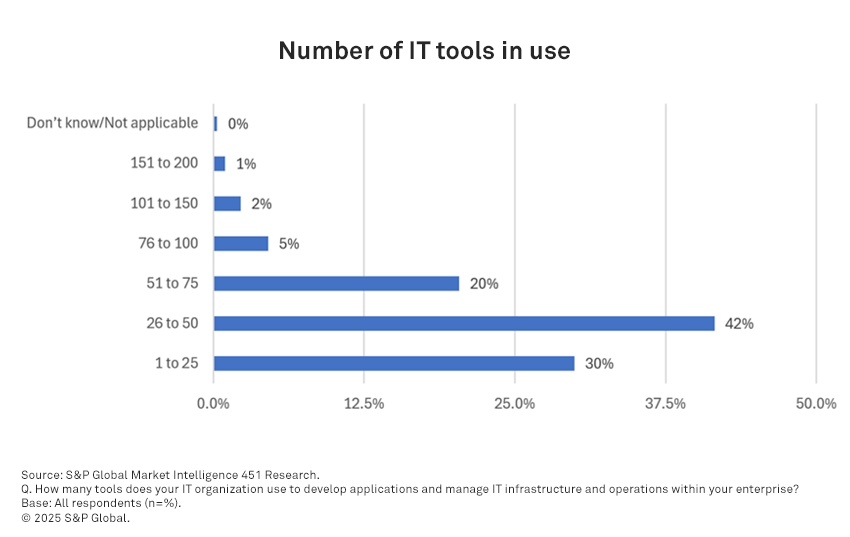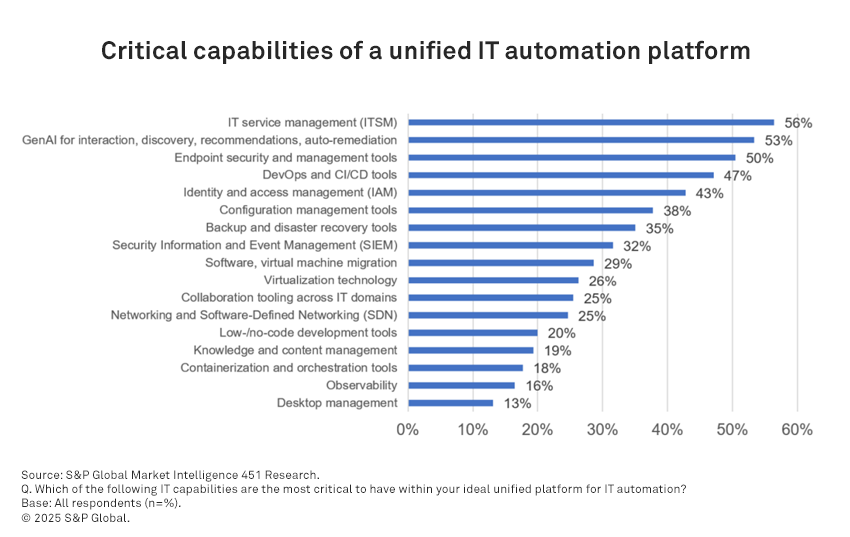
Source: Luis Alvarez/Stock Photos Office/via Getty Images.
As IT departments grapple with the complexities of managing hybrid environments and integrating disparate tools, the rise of unified IT automation platforms offers a beacon of hope. These platforms, powered by artificial intelligence (AI), promise to orchestrate processes across the IT landscape, reducing tool sprawl and enhancing operational efficiency.
The challenges of tool sprawl
Organizations today face a daunting challenge: tool sprawl. According to a recent survey conducted by S&P Global Market Intelligence 451 Research, 72% of surveyed organizations use up to 50 different IT tools, while 28% report using over 50. This proliferation of tools can drain productivity, as IT teams spend valuable time ensuring interoperability rather than focusing on strategic initiatives. The complexity of integrating these tools, coupled with lengthy implementation processes and cost constraints, can further exacerbate these challenges.

The rise of platform engineering
To combat these challenges, many organizations have turned to platform engineering (PE) initiatives.
PE represents an emerging set of practices and technologies that originally set out to accelerate application development, delivery and execution. PE built upon earlier DevOps and site reliability engineering (SRE) practices by building platforms composed of standardized tools, technologies and workflows that provide self-service capabilities to developers and help automatically manage, provision and operate complex software development and runtime environments.
Today PE is playing a more expanded role. PE teams are also building platforms for other purposes such as for infrastructure provisioning (a.k.a. infrastructure-as-code), cloud operations, hybrid architecture management, collaboration, and for any other type of IT function.
These initiatives have gained traction, with 69% of organizations surveyed launching PE programs or allocating resources to integrate disparate tools. PE not only facilitates tool interoperability but also enhances scalability, consistency, and customer service within IT operations.
Are unified IT automation platforms a solution?
A unified IT automation platform can be defined as a centralized control plane that leverages AI to
integrate, automate and orchestrate multiple IT tools, processes and resources and facilitates
collaboration across an organization’s entire IT environment. Unified IT automation platforms enable IT teams to focus on strategic goals rather than reinventing automation solutions. By minimizing custom integrations, these platforms could be the solution to reducing tool sprawl and enhance efficiency across organizations.
Critical capabilities and drivers
In the same study conducted by S&P Global Market Intelligence 451 Research, organizations shared the critical capabilities required of unified IT automation platforms. IT service management (56%) and generative AI (53%) were cited as being top priorities, followed by endpoint security, (50%), DevOps (47%), identity access management (43%), and configuration management tools (38%). These platforms promise to deliver comprehensive automation capabilities across multiple IT domains, supporting a wide range of use cases and providing a seamless user experience.
The primary drivers for adopting unified IT automation platforms include increased efficiency and productivity (cited by 54% of the respondents), increased agility and responsiveness (43%), and reduced manual and human error (40%).

Vendor offerings
Several vendors offer unified IT automation platforms, each with unique capabilities. For instance, Amazon Web Services provides CloudFormation for infrastructure-as-code, while BMC Software’s Helix platform offers AI-driven automated IT operations management. Other notable vendors include VMware, Dynatrace, Microsoft Azure, and Red Hat, each contributing to the evolving landscape of IT automation.
Conclusion
The expanding landscape of hybrid IT estates calls for improved interoperability among myriad IT tools. Unified IT automation platforms, powered by AI, are poised to play a vital role in enabling this interoperability, driving greater value from platform engineering initiatives, and enhancing the efficiency of IT organizations. As automation becomes a priority, organizations are increasingly allocating larger portions of their IT budgets to these initiatives, recognizing the intertwined nature of automation and AI strategies.
In a world where technology continues to evolve rapidly, unified IT automation platforms offer a path to streamlined operations, allowing organizations to efficiently navigate the complexities of modern IT environments.
Want insights on IoT trends delivered to your inbox? Join the 451 Alliance.
This content may be AI-assisted and is composed, reviewed, edited and approved by S&P Global in accordance with our Terms of Service.

